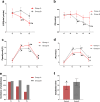Driving pressure-guided dynamic PEEP titration reduces atelectasis and improves oxygenation in pediatric laparoscopy: a randomized trial on personalized ventilation strategies
- PMID: 40835897
- PMCID: PMC12365997
- DOI: 10.1186/s12871-025-03274-w
Driving pressure-guided dynamic PEEP titration reduces atelectasis and improves oxygenation in pediatric laparoscopy: a randomized trial on personalized ventilation strategies
Abstract
Background: Pediatric laparoscopic surgery often induces atelectasis due to pneumoperitoneum, postural changes, and immature respiratory physiology, increasing postoperative pulmonary complications (PPCs). Fixed PEEP may fail to address perioperative variability. This study evaluated whether dynamic PEEP adjustment reduces atelectasis and improves oxygenation.
Methods: Children at moderate or high risk of PPCs undergoing elective laparoscopic surgery were randomized into two groups. Group A had driving pressure-guided individualized PEEP titration at three specified time points: after intubation, before pneumoperitoneum initiation, and after pneumoperitoneum completion. Group B had individualized PEEP titration only after intubation, with this PEEP maintained until the end of ventilation. Both groups received alveolar recruitment maneuvers (ARMs). Observations were conducted at 5 min after tracheal intubation (T1), 20 min post-pneumoperitoneum (T2), 60 min post-pneumoperitoneum (T3), at the end of surgery (T4), and at extubation (T5). The primary outcome were intraoperative lung ultrasound score. Secondary outcomes included incidence of atelectasis, oxygenation index, peak airway pressure, plateau pressure, PEEP, driving pressure, dynamic lung compliance, mean arterial pressure, and heart rate.
Results: At T4 and T5, Group A showed significantly lower subpleural consolidation scores, total lung ultrasound scores, and atelectasis rates versus Group B (P < 0.05). Oxygenation indices in Group A were higher at T3–T5 (P < 0.05). Post-pneumoperitoneum, Group A’s median PEEP increased to 8 cmH2O (vs. Group B), with lower driving pressure and higher dynamic compliance (P < 0.05). Hemodynamic parameters showed no intergroup differences (P > 0.05).
Conclusion: Driving pressure-guided dynamic PEEP titration reduces postoperative lung ultrasound abnormalities and atelectasis while improving oxygenation and respiratory mechanics in pediatric laparoscopy, without compromising hemodynamic stability. This strategy supports personalized PEEP optimization.
Trial registration: This trial was registered on Clinical Trials.gov (Registration No. ChiCTR2300070193, Registration date: 2023-04-04). The trial was retrospectively registered as enrollment began prior to registration.
Supplementary Information: The online version contains supplementary material available at 10.1186/s12871-025-03274-w.
Keywords: Atelectasis; Children; Individualized positive end-expiratory pressure; Laparoscopic surgery; Postoperative pulmonary complications.
Conflict of interest statement
Declarations. Ethics approval and consent to participate: This study complied with the principles of the Declaration of Helsinki and was approved by the Ethics Committee of Kunming Children’s Hospital (Approval No. 2022-03-396-K01). For the 68 participants under 16 years of age included in this study, written informed consent was obtained from their legal guardians, with additional verbal assent from the participants themselves where age-appropriate, and data anonymity was ensured throughout the research. Consent for publication: Not applicable. Competing interests: The authors declare no competing interests.
Figures
Similar articles
-
Effect of driving pressure-guided individualized positive end-expiratory pressure (PEEP) ventilation strategy on postoperative atelectasis in patients undergoing laparoscopic surgery as assessed by ultrasonography: study protocol for a prospective randomized controlled trial.Trials. 2025 Mar 26;26(1):106. doi: 10.1186/s13063-025-08819-5. Trials. 2025. PMID: 40140868 Free PMC article.
-
Effect of individualized PEEP titrated by EIT on postoperative atelectasis in children undergoing laparoscopy: A randomized controlled trial.Int J Med Sci. 2025 Jun 12;22(12):3007-3013. doi: 10.7150/ijms.112280. eCollection 2025. Int J Med Sci. 2025. PMID: 40657398 Free PMC article. Clinical Trial.
-
Effects of dynamic individualized PEEP guided by driving pressure in laparoscopic surgery on postoperative atelectasis in elderly patients: a prospective randomized controlled trial.BMC Anesthesiol. 2022 Mar 16;22(1):72. doi: 10.1186/s12871-022-01613-9. BMC Anesthesiol. 2022. PMID: 35296253 Free PMC article. Clinical Trial.
-
Effects of Individualized Positive End-Expiratory Pressure on Patients Undergoing One-Lung Ventilation During Thoracic Surgery: A Systematic Review and Meta-Analysis.J Cardiothorac Vasc Anesth. 2025 Jul 11:S1053-0770(25)00483-5. doi: 10.1053/j.jvca.2025.06.019. Online ahead of print. J Cardiothorac Vasc Anesth. 2025. PMID: 40783324 Review.
-
Individualized positive end-expiratory pressure guided by respiratory mechanics during anesthesia for the prevention of postoperative pulmonary complications: a systematic review and meta-analysis.J Clin Monit Comput. 2023 Apr;37(2):365-377. doi: 10.1007/s10877-022-00960-9. Epub 2023 Jan 6. J Clin Monit Comput. 2023. PMID: 36607532
References
-
- Grieco D L, Russo A, Anzellotti G M, et al. Lung-protective ventilation during Trendelenburg Pneumoperitoneum surgery: A randomized clinical trial. J Clin Anesth. 2023;85:111037. - PubMed
-
- Pereira S M, Tucci M R, Morais C C A, et al. Individual positive End-expiratory pressure settings optimize intraoperative mechanical ventilation and reduce postoperative atelectasis [J]. Anesthesiology. 2018;129(6):1070–81. - PubMed
-
- Li X, Liu H, Wang J, et al. Individualized positive End-expiratory pressure on postoperative atelectasis in patients with obesity: A randomized controlled clinical trial. Anesthesiology. 2023;139(3):262–73. - PubMed
Grants and funding
LinkOut - more resources
Full Text Sources




